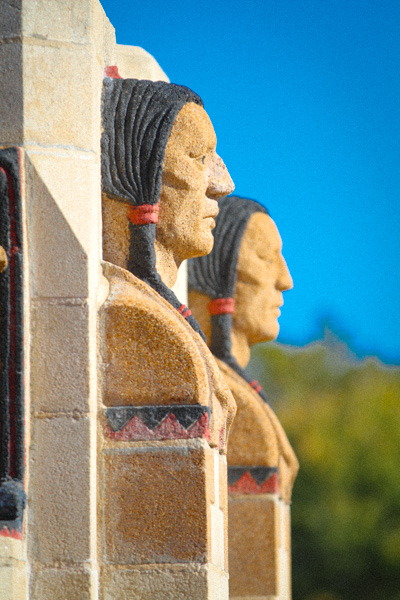Address: 13th Street, Wichita KS
Phone:
Website:



In the early 20th century, white and gray cast stone was a common building material and the Cement Stone & Supply Company of Wichita gave their product the brand name "Carthalite." In the 1920s and 1930s they went on to adapt the unusual aspect of adding color to some of their concrete. Mineral pigments and crushed colored glass were combined with the concrete mix to create beautifully colored designs to add to the surfaces of buildings. To date fourteen examples have been identified in Wichita and this characteristic seems be quite rare in the Central Plains states, possibly in the entire country.
Colored Carthalite was applied to a variety of structures ranging from a bungalow residence to a synagogue and several schools, and it adds art deco flair to these otherwise average brick buildings.
The Carthalite subtle colors are found on the surfaces of the cast-stone panels decorating 11 structures in Wichita They appear to be painted on white or gray concrete. In fact, the geometric and vurvilinear designs are colored sections of concrete than penetrate in to the cast pieces.
Cement Stone and Supply Company created the unusual colored decorative elements that appeared on a relatively few buildings between 1927 and 1940.
Historically, the use of color has been common when casting concrete; powdered mineral oxide pigments were, and are, used to tint entire cast pieces in various shades. But the precise, ornamental effects of colored cast stone that were created the by Cement Stone and Supply Company took the process to an apparently unprecedented new level. In addition to adding pigments, the company introduced another innovation by using crushed colored glass as an aggregate in some of its designs. These tiny translucent shards are quite evident in the Native American motifs on Minisa Bridge (covered until October 2008) and the patterns on the WPA Comfort Station in North Riverside Park.
(Thanks to Barbara Hammond, Wichita Historic Preservation Office, for the above information)
A Sampling of Carthalite Structures in Wichita:
Minisa Bridge, 13th Street, 2 blocks west of Waco
Kansas Aviation Museum, 3350 S. George Washington Blvd.
Dockum Drug Store Building, 3200 E. Douglas Ave.
Allen's Market Building, 2938 E. Douglas Ave.
Synagogue Ahavath Achim Building, 156 S. Kansas
Griffin Architectural Office Building, 416 S. Market
Wichita North High School Flag Pole, 13th and Rochester Street
North Riverside Park Comfort Station, 9th Street, 1 block west of Nims Ave.


